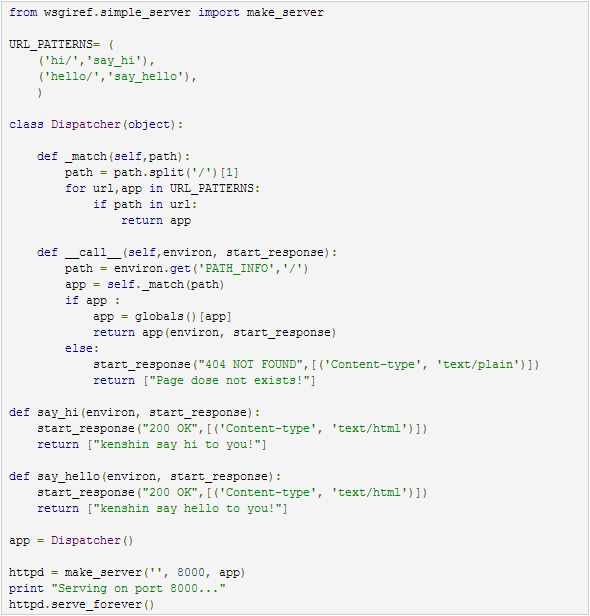WSGI(Web Sever Gateway Interface):分为服务器端(Sever)和应用程序端(App)
①服务器端:接收请求,给应用程序提供environ(环境信息)和start_response(回调函数)。这个回调函数,返回httpheader数据以及status信息。
②应用程序端:可调用对象,包括不仅限函数,类,含__call__方法的实例。用于处理请求,返回header/body/status给服务器。
【WSGI App】:
1、接收服务器端传来的environ和start_response。
2、回调函数接收两个参数:status和response_header。
3、WSGI app通过回调函数,将response.header/status返回给WSGI server。
4、WSGI app最后再返回一个可迭代对象,就是response.body。
def application(environ, start_response):
status = '200 OK' # http状态码
response_headers = [('Content-type', 'text/plain')] # 由二元tuple组成的list
start_response(status, response_headers)
return iterator
PS:
1、回调函数必须在WSGI app返回可迭代数据之前被调用,因为它返回的是数据header部分。且仅能调用一次。
2、禁止回调函数直接将 response headers回传,必须把它们存储起来,直到WSGI app第一次迭代返回非空数据后,才能传递给客户端。
【WSGI Server】工作流程:
1、服务器创建socket连接,并监听端口,等待客户端连接;
2、接收到请求,解析客户端信息放到environ中,根据url调用对应的路由视图函数来处理;
3、视图函数解析http请求,再将methods、path、服务器数据等信息全部存入environ。
4、WSGI sever调用WSGI app(应用程序),并将environ和start_response传给WSGI app;
5、WSGI app将responseheader/status/body回传给WSGI sever;
6、视图函数通过socket将response信息传给客户端
def run(application):
environ = {} #由server准备environ数据
def start_response(status, response_headers, exc_info=None): #由server提供处理方法
pass
result = application(environ, start_response) #调用WSGI app
def write(data):
pass
for data in result: #迭代访问WSGI app返回header/status/body
write(data)
用middleware实现URL路由,对应用程序进行一层层的包装,就可以实现各种功能。这是框架的形成原理。























 923
923

 被折叠的 条评论
为什么被折叠?
被折叠的 条评论
为什么被折叠?








